climate control FIAT DOBLO COMBI 2012 Owner handbook (in English)
[x] Cancel search | Manufacturer: FIAT, Model Year: 2012, Model line: DOBLO COMBI, Model: FIAT DOBLO COMBI 2012Pages: 283, PDF Size: 6.31 MB
Page 57 of 283
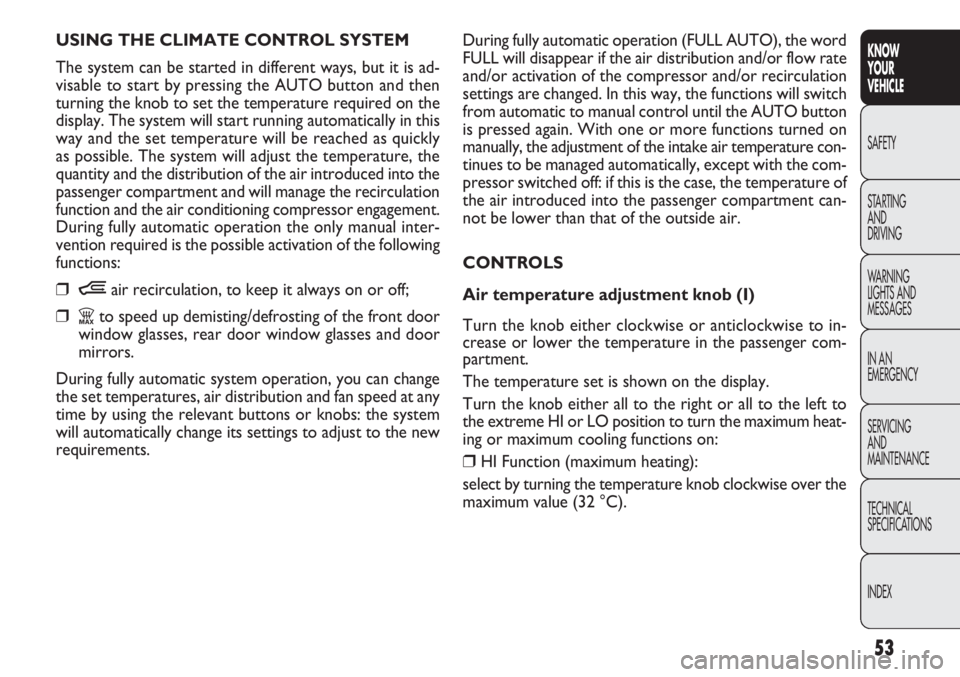
53
KNOW
YOUR
VEHICLE
SAFETY
STAR
TING
AND
DRIVING
WARNING
LIGHTS AND
MESSAGES
IN AN
EMERGENCY
SERVICING
AND
MAINTENANCE
TECHNICAL
SPECIFICATIONS
INDEX
During fully automatic operation (FULL AUTO), the word
FULL will disappear if the air distribution and/or flow rate
and/or activation of the compressor and/or recirculation
settings are changed. In this way, the functions will switch
from automatic to manual control until the AUTO button
is pressed again. With one or more functions turned on
manually, the adjustment of the intake air temperature con-
tinues to be managed automatically, except with the com-
pressor switched off: if this is the case, the temperature of
the air introduced into the passenger compartment can-
not be lower than that of the outside air.
CONTROLS
Air temperature adjustment knob (I)
Turn the knob either clockwise or anticlockwise to in-
crease or lower the temperature in the passenger com-
partment.
The temperature set is shown on the display.
Turn the knob either all to the right or all to the left to
the extreme HI or LO position to turn the maximum heat-
ing or maximum cooling functions on:
❒HI Function (maximum heating):
select by turning the temperature knob clockwise over the
maximum value (32 °C).
USING THE CLIMATE CONTROL SYSTEM
The system can be started in different ways, but it is ad-
visable to start by pressing the AUTO button and then
turning the knob to set the temperature required on the
display. The system will start running automatically in this
way and the set temperature will be reached as quickly
as possible. The system will adjust the temperature, the
quantity and the distribution of the air introduced into the
passenger compartment and will manage the recirculation
function and the air conditioning compressor engagement.
During fully automatic operation the only manual inter-
vention required is the possible activation of the following
functions:
❒Ò
air recirculation, to keep it always on or off;
❒Zto speed up demisting/defrosting of the front door
window glasses, rear door window glasses and door
mirrors.
During fully automatic system operation, you can change
the set temperatures, air distribution and fan speed at any
time by using the relevant buttons or knobs: the system
will automatically change its settings to adjust to the new
requirements.
Page 59 of 283
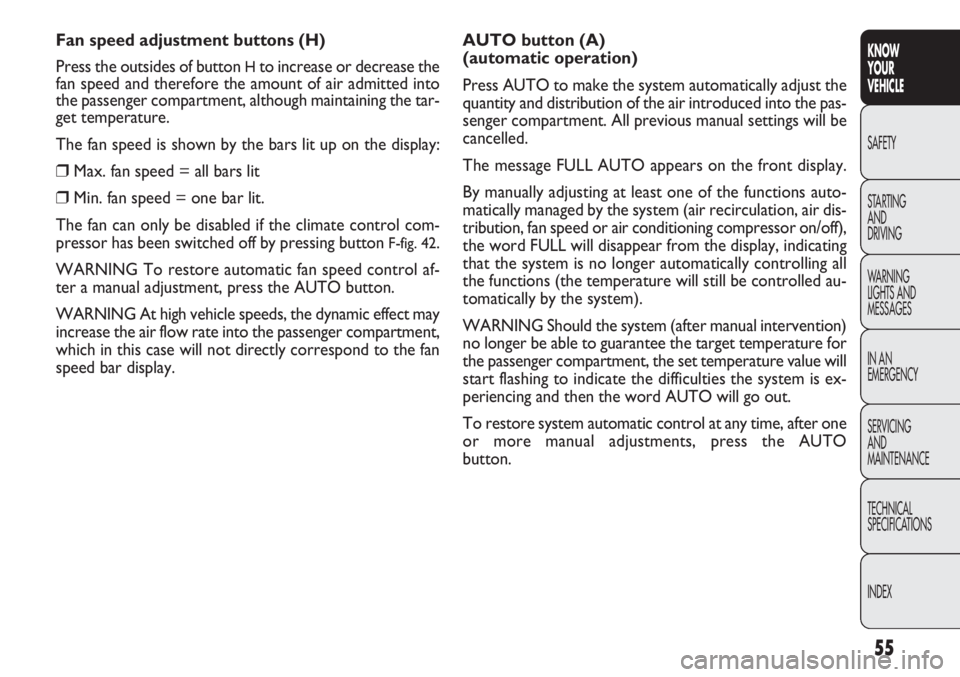
55
KNOW
YOUR
VEHICLE
SAFETY
STAR
TING
AND
DRIVING
WARNING
LIGHTS AND
MESSAGES
IN AN
EMERGENCY
SERVICING
AND
MAINTENANCE
TECHNICAL
SPECIFICATIONS
INDEX
AUTO button (A)
(automatic operation)
Press AUTO to make the system automatically adjust the
quantity and distribution of the air introduced into the pas-
senger compartment. All previous manual settings will be
cancelled.
The message FULL AUTO appears on the front display.
By manually adjusting at least one of the functions auto-
matically managed by the system (air recirculation, air dis-
tribution, fan speed or air conditioning compressor on/off),
the word FULL will disappear from the display, indicating
that the system is no longer automatically controlling all
the functions (the temperature will still be controlled au-
tomatically by the system).
WARNING Should the system (after manual intervention)
no longer be able to guarantee the target temperature for
the passenger compartment, the set temperature value will
start flashing to indicate the difficulties the system is ex-
periencing and then the word AUTO will go out.
To restore system automatic control at any time, after one
or more manual adjustments, press the AUTO
button.
Fan speed adjustment buttons (H)
Press the outsides of button
Hto increase or decrease the
fan speed and therefore the amount of air admitted into
the passenger compartment, although maintaining the tar-
get temperature.
The fan speed is shown by the bars lit up on the display:
❒Max. fan speed = all bars lit
❒Min. fan speed = one bar lit.
The fan can only be disabled if the climate control com-
pressor has been switched off by pressing button
F-fig. 42.
WARNING To restore automatic fan speed control af-
ter a manual adjustment, press the AUTO button.
WARNING At high vehicle speeds, the dynamic effect may
increase the air flow rate into the passenger compartment,
which in this case will not directly correspond to the fan
speed bar display.
Page 60 of 283
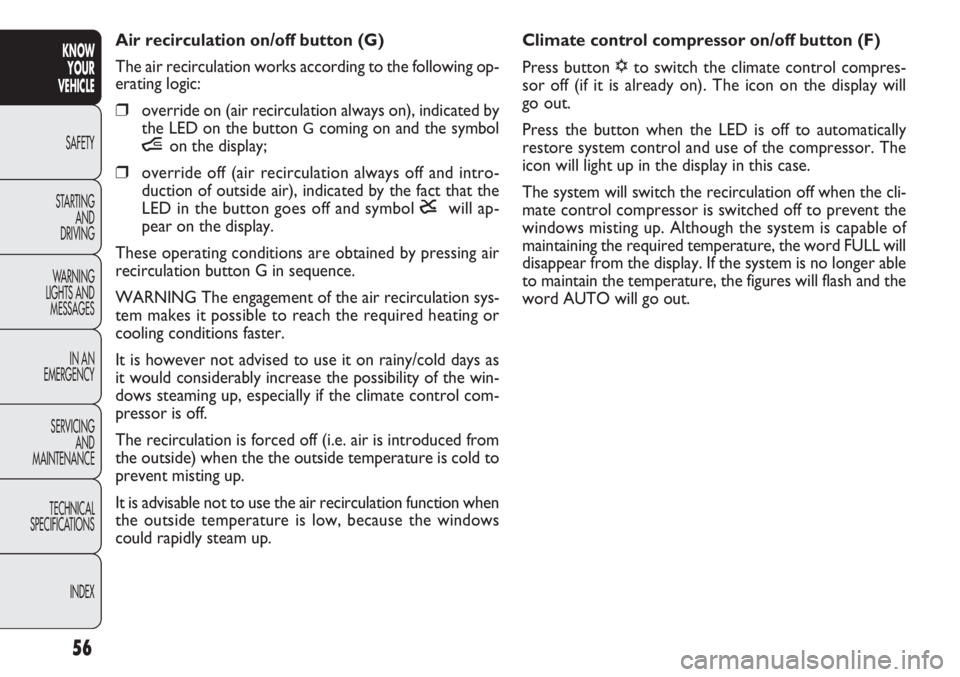
56
KNOWYOUR
VEHICLE
SAFETY
ST AR
TING AND
DRIVING
WARNING
LIGHTS AND MESSAGES
IN AN
EMERGENCY
SERVICING AND
MAINTENANCE
TECHNICAL
SPECIFICATIONS
INDEX
Climate control compressor on/off button (F)
Press button √to switch the climate control compres-
sor off (if it is already on). The icon on the display will
go out.
Press the button when the LED is off to automatically
restore system control and use of the compressor. The
icon will light up in the display in this case.
The system will switch the recirculation off when the cli-
mate control compressor is switched off to prevent the
windows misting up. Although the system is capable of
maintaining the required temperature, the word FULL will
disappear from the display. If the system is no longer able
to maintain the temperature, the figures will flash and the
word AUTO will go out.
Air recirculation on/off button (G)
The air recirculation works according to the following op-
erating logic:
❒override on (air recirculation always on), indicated by
the LED on the button
Gcoming on and the symbol
í on the display;
❒override off (air recirculation always off and intro-
duction of outside air), indicated by the fact that the
LED in the button goes off and symbol ê will ap-
pear on the display.
These operating conditions are obtained by pressing air
recirculation button G in sequence.
WARNING The engagement of the air recirculation sys-
tem makes it possible to reach the required heating or
cooling conditions faster.
It is however not advised to use it on rainy/cold days as
it would considerably increase the possibility of the win-
dows steaming up, especially if the climate control com-
pressor is off.
The recirculation is forced off (i.e. air is introduced from
the outside) when the the outside temperature is cold to
prevent misting up.
It is advisable not to use the air recirculation function when
the outside temperature is low, because the windows
could rapidly steam up.
Page 61 of 283
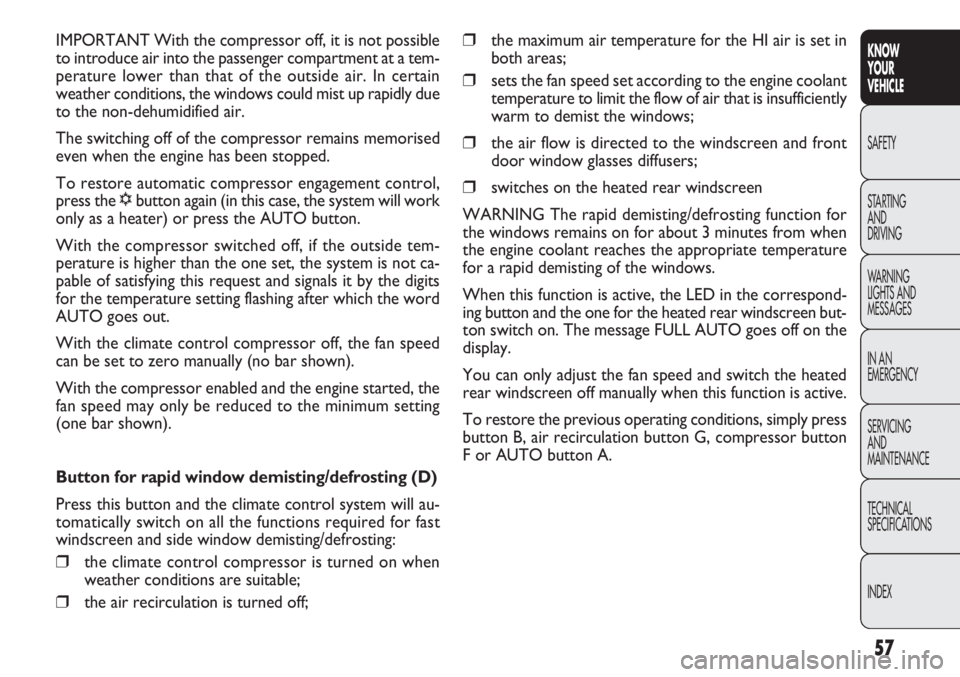
57
KNOW
YOUR
VEHICLE
SAFETY
STAR
TING
AND
DRIVING
WARNING
LIGHTS AND
MESSAGES
IN AN
EMERGENCY
SERVICING
AND
MAINTENANCE
TECHNICAL
SPECIFICATIONS
INDEX
❒the maximum air temperature for the HI air is set in
both areas;
❒sets the fan speed set according to the engine coolant
temperature to limit the flow of air that is insufficiently
warm to demist the windows;
❒the air flow is directed to the windscreen and front
door window glasses diffusers;
❒switches on the heated rear windscreen
WARNING The rapid demisting/defrosting function for
the windows remains on for about 3 minutes from when
the engine coolant reaches the appropriate temperature
for a rapid demisting of the windows.
When this function is active, the LED in the correspond-
ing button and the one for the heated rear windscreen but-
ton switch on. The message FULL AUTO goes off on the
display.
You can only adjust the fan speed and switch the heated
rear windscreen off manually when this function is active.
To restore the previous operating conditions, simply press
button B, air recirculation button G, compressor button
F or AUTO button A.
IMPORTANT With the compressor off, it is not possible
to introduce air into the passenger compartment at a tem-
perature lower than that of the outside air. In certain
weather conditions, the windows could mist up rapidly due
to the non-dehumidified air.
The switching off of the compressor remains memorised
even when the engine has been stopped.
To restore automatic compressor engagement control,
press the √
button again (in this case, the system will work
only as a heater) or press the AUTO button.
With the compressor switched off, if the outside tem-
perature is higher than the one set, the system is not ca-
pable of satisfying this request and signals it by the digits
for the temperature setting flashing after which the word
AUTO goes out.
With the climate control compressor off, the fan speed
can be set to zero manually (no bar shown).
With the compressor enabled and the engine started, the
fan speed may only be reduced to the minimum setting
(one bar shown).
Button for rapid window demisting/defrosting (D)
Press this button and the climate control system will au-
tomatically switch on all the functions required for fast
windscreen and side window demisting/defrosting:
❒the climate control compressor is turned on when
weather conditions are suitable;
❒the air recirculation is turned off;
Page 62 of 283
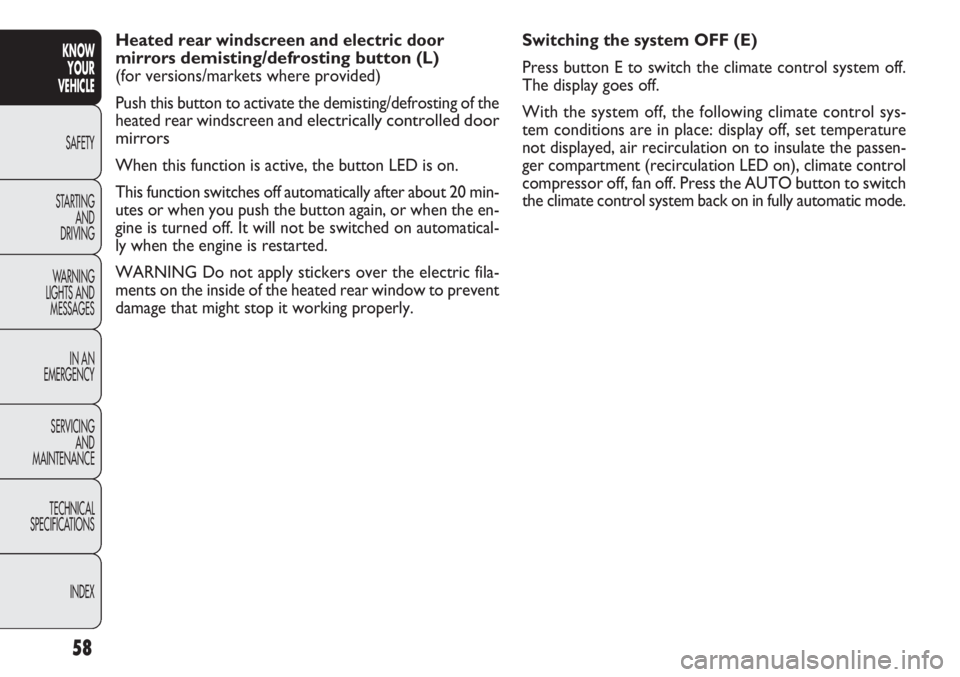
58
KNOWYOUR
VEHICLE
SAFETY
ST AR
TING AND
DRIVING
WARNING
LIGHTS AND MESSAGES
IN AN
EMERGENCY
SERVICING AND
MAINTENANCE
TECHNICAL
SPECIFICATIONS
INDEX
Switching the system OFF (E)
Press button E to switch the climate control system off.
The display goes off.
With the system off, the following climate control sys-
tem conditions are in place: display off, set temperature
not displayed, air recirculation on to insulate the passen-
ger compartment (recirculation LED on), climate control
compressor off, fan off. Press the AUTO button to switch
the climate control system back on in fully automatic mode.
Heated rear windscreen and electric door
mirrors
demisting/defrosting button(L)
(for versions/markets where provided)
Push this button to activate the demisting/defrosting of the
heated rear windscreen
and electrically controlled door
mirrors
When this function is active, the button LED is on.
This function switches off automatically after about 20 min-
utes or when you push the button again, or when the en-
gine is turned off. It will not be switched on automatical-
ly when the engine is restarted.
WARNING Do not apply stickers over the electric fila-
ments on the inside of the heated rear window to prevent
damage that might stop it working properly.
Page 110 of 283
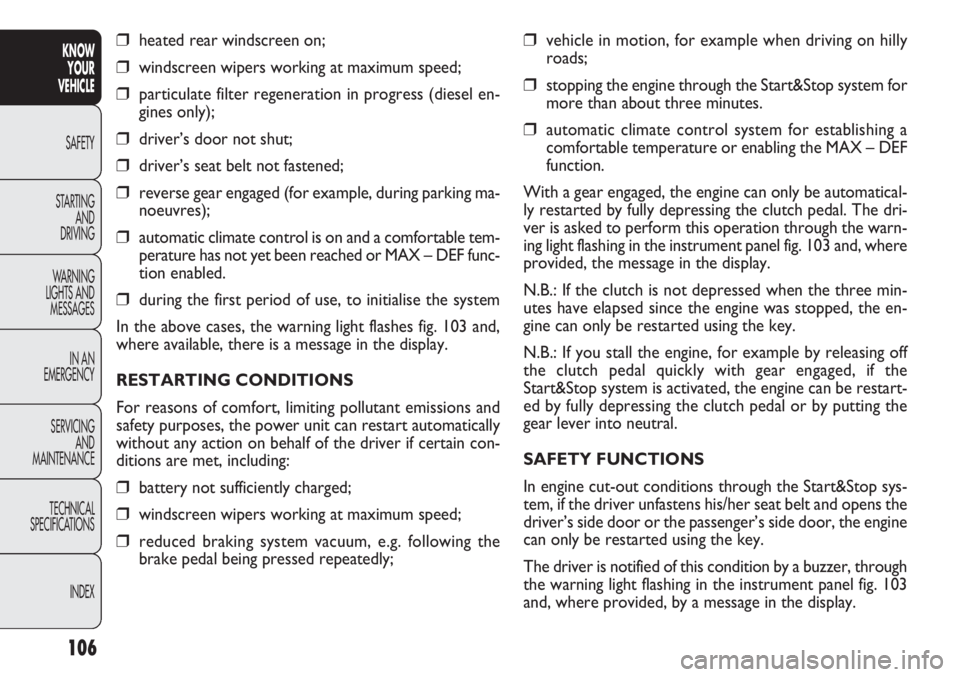
❒vehicle in motion, for example when driving on hilly
roads;
❒stopping the engine through the Start&Stop system for
more than about three minutes.
❒automatic climate control system for establishing a
comfortable temperature or enabling the MAX – DEF
function.
With a gear engaged, the engine can only be automatical-
ly restarted by fully depressing the clutch pedal. The dri-
ver is asked to perform this operation through the warn-
ing light flashing in the instrument panel fig. 103 and, where
provided, the message in the display.
N.B.: If the clutch is not depressed when the three min-
utes have elapsed since the engine was stopped, the en-
gine can only be restarted using the key.
N.B.: If you stall the engine, for example by releasing off
the clutch pedal quickly with gear engaged, if the
Start&Stop system is activated, the engine can be restart-
ed by fully depressing the clutch pedal or by putting the
gear lever into neutral.
SAFETY FUNCTIONS
In engine cut-out conditions through the Start&Stop sys-
tem, if the driver unfastens his/her seat belt and opens the
driver’s side door or the passenger’s side door, the engine
can only be restarted using the key.
The driver is notified of this condition by a buzzer, through
the warning light flashing in the instrument panel fig. 103
and, where provided, by a message in the display.
106
KNOW YOUR
VEHICLE
SAFETY
ST AR
TING AND
DRIVING
WARNING
LIGHTS AND MESSAGES
IN AN
EMERGENCY
SERVICING AND
MAINTENANCE
TECHNICAL
SPECIFICATIONS
INDEX
❒heated rear windscreen on;
❒windscreen wipers working at maximum speed;
❒particulate filter regeneration in progress (diesel en-
gines only);
❒driver’s door not shut;
❒driver’s seat belt not fastened;
❒reverse gear engaged (for example, during parking ma-
noeuvres);
❒automatic climate control is on and a comfortable tem-
perature has not yet been reached or MAX – DEF func-
tion enabled.
❒during the first period of use, to initialise the system
In the above cases, the warning light flashes fig. 103 and,
where available, there is a message in the display.
RESTARTING CONDITIONS
For reasons of comfort, limiting pollutant emissions and
safety purposes, the power unit can restart automatically
without any action on behalf of the driver if certain con-
ditions are met, including:
❒battery not sufficiently charged;
❒windscreen wipers working at maximum speed;
❒reduced braking system vacuum, e.g. following the
brake pedal being pressed repeatedly;
Page 113 of 283
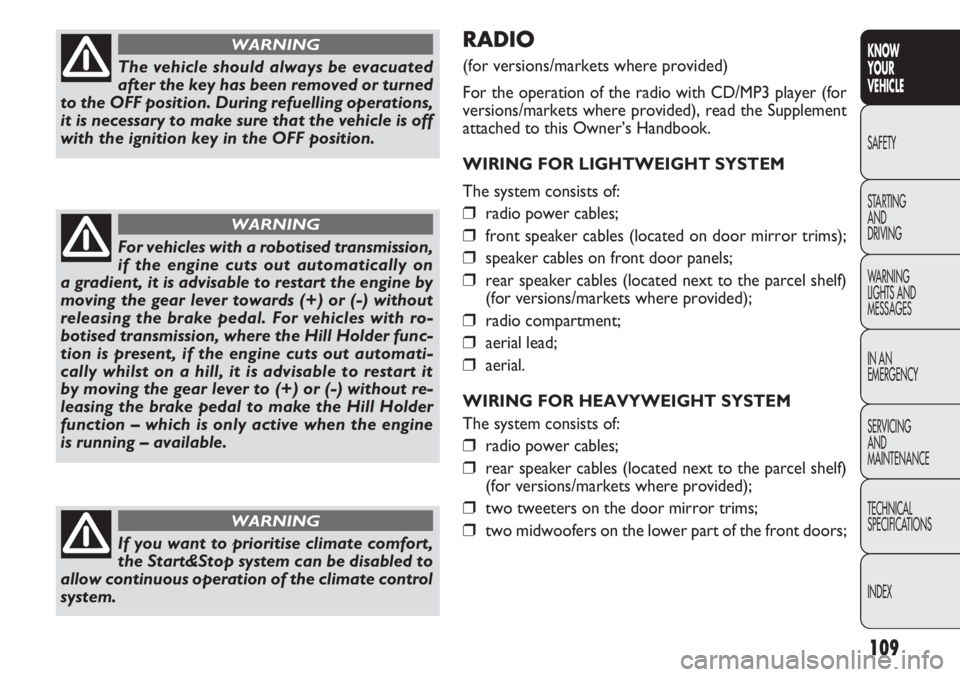
109
KNOW
YOUR
VEHICLE
SAFETY
STAR
TING
AND
DRIVING
WARNING
LIGHTS AND
MESSAGES
IN AN
EMERGENCY
SERVICING
AND
MAINTENANCE
TECHNICAL
SPECIFICATIONS
INDEX
RADIO
(for versions/markets where provided)
For the operation of the radio with CD/MP3 player (for
versions/markets where provided), read the Supplement
attached to this Owner’s Handbook.
WIRING FOR LIGHTWEIGHT SYSTEM
The system consists of:
❒radio power cables;
❒front speaker cables (located on door mirror trims);
❒speaker cables on front door panels;
❒rear speaker cables (located next to the parcel shelf)
(for versions/markets where provided);
❒radio compartment;
❒aerial lead;
❒aerial.
WIRING FOR HEAVYWEIGHT SYSTEM
The system consists of:
❒radio power cables;
❒rear speaker cables (located next to the parcel shelf)
(for versions/markets where provided);
❒two tweeters on the door mirror trims;
❒two midwoofers on the lower part of the front doors;
The vehicle should always be evacuated
after the key has been removed or turned
to the OFF position. During refuelling operations,
it is necessary to make sure that the vehicle is off
with the ignition key in the OFF position.
WARNING
For vehicles with a robotised transmission,
if the engine cuts out automatically on
a gradient, it is advisable to restart the engine by
moving the gear lever towards (+) or (-) without
releasing the brake pedal. For vehicles with ro-
botised transmission, where the Hill Holder func-
tion is present, if the engine cuts out automati-
cally whilst on a hill, it is advisable to restart it
by moving the gear lever to (+) or (-) without re-
leasing the brake pedal to make the Hill Holder
function – which is only active when the engine
is running – available.
WARNING
If you want to prioritise climate comfort,
the Start&Stop system can be disabled to
allow continuous operation of the climate control
system.
WARNING
Page 142 of 283
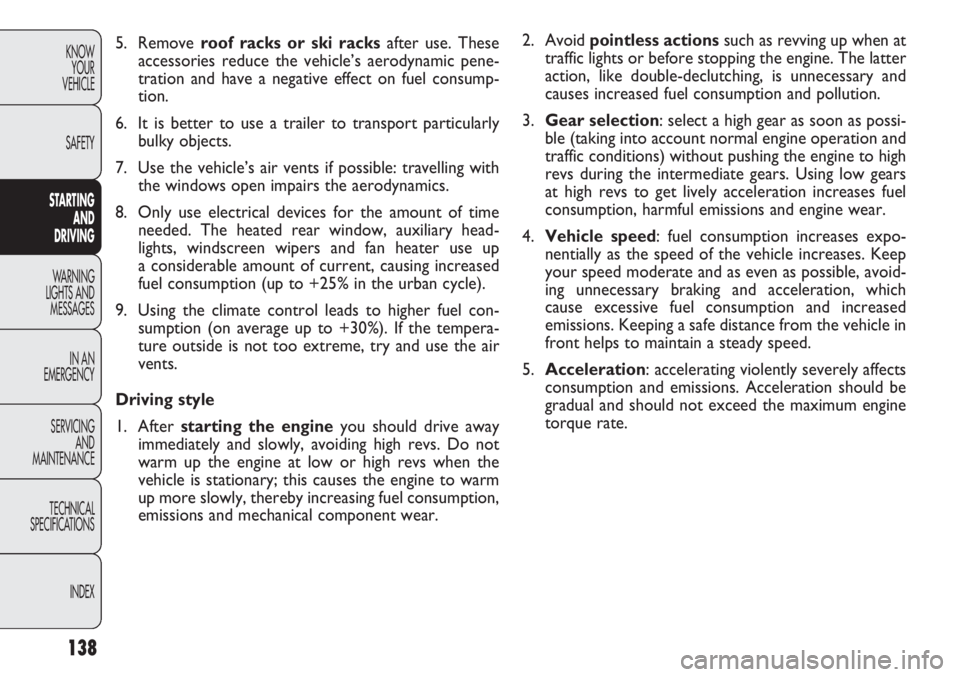
138
KNOWYOUR
VEHICLE
SAFETY
ST ARTING
AN
D
DRIVING
WARNING
LIGHTS AND MESSAGES
IN AN
EMERGENCY
SERVICING AND
MAINTENANCE
TECHNICAL
SPECIFICA TIONS
INDEX
2. Avoid pointless actions such as revving up when at
traffic lights or before stopping the engine. The latter
action, like double-declutching, is unnecessary and
causes increased fuel consumption and pollution.
3. Gear selection: select a high gear as soon as possi-
ble (taking into account normal engine operation and
traffic conditions) without pushing the engine to high
revs during the intermediate gears. Using low gears
at high revs to get lively acceleration increases fuel
consumption, harmful emissions and engine wear.
4. Vehicle speed: fuel consumption increases expo-
nentially as the speed of the vehicle increases. Keep
your speed moderate and as even as possible, avoid-
ing unnecessary braking and acceleration, which
cause excessive fuel consumption and increased
emissions. Keeping a safe distance from the vehicle in
front helps to maintain a steady speed.
5. Acceleration: accelerating violently severely affects
consumption and emissions. Acceleration should be
gradual and should not exceed the maximum engine
torque rate.
5. Remove
roof racks or ski racks after use. These
accessories reduce the vehicle’s aerodynamic pene-
tration and have a negative effect on fuel consump-
tion.
6. It is better to use a trailer to transport particularly bulky objects.
7. Use the vehicle’s air vents if possible: travelling with the windows open impairs the aerodynamics.
8. Only use electrical devices for the amount of time needed. The heated rear window, auxiliary head-
lights, windscreen wipers and fan heater use up
a considerable amount of current, causing increased
fuel consumption (up to +25% in the urban cycle).
9. Using the climate control leads to higher fuel con- sumption (on average up to +30%). If the tempera-
ture outside is not too extreme, try and use the air
vents.
Driving style
1. After starting the engine you should drive away
immediately and slowly, avoiding high revs. Do not
warm up the engine at low or high revs when the
vehicle is stationary; this causes the engine to warm
up more slowly, thereby increasing fuel consumption,
emissions and mechanical component wear.
Page 187 of 283
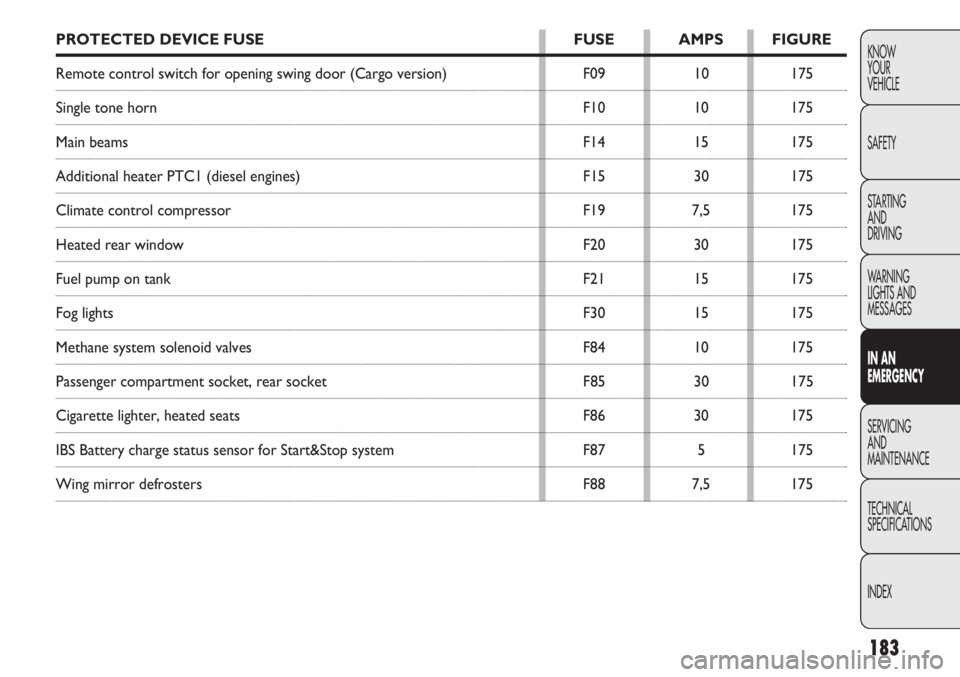
183
KNOW
YOUR
VEHICLE
SAFETY
STARTING
AND
DRIVING
WARNING
LIGHTS AND
MESSAGES
IN AN
EMERGENCY
SERVICING
AND
MAINTENANCE
TECHNICAL
SPECIFICATIONS
INDEXPROTECTED DEVICE FUSE FUSE AMPS FIGURE
Remote control switch for opening swing door (Cargo version) F0910175
Single tone horn F1010175
Main beams F1415175
Additional heater PTC1 (diesel engines) F1530175
Climate control compressor F197,5175
Heated rear window F2030175
Fuel pump on tank F2115175
Fog lights F3015175
Methane system solenoid valves F8410175
Passenger compartment socket, rear socket F8530175
Cigarette lighter, heated seats F8630175
IBS Battery charge status sensor for Start&Stop system F875175
Wing mirror defrosters F887,5175
Page 189 of 283
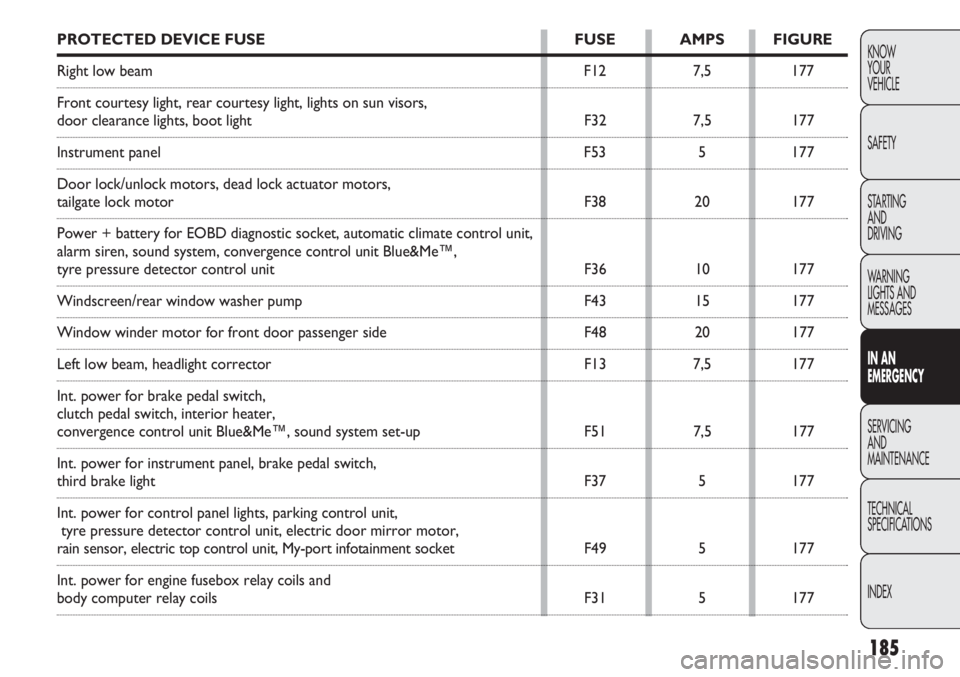
185
KNOW
YOUR
VEHICLE
SAFETY
STARTING
AND
DRIVING
WARNING
LIGHTS AND
MESSAGES
IN AN
EMERGENCY
SERVICING
AND
MAINTENANCE
TECHNICAL
SPECIFICATIONS
INDEXPROTECTED DEVICE FUSE FUSE AMPS FIGURE
Right low beam F127,5177
Front courtesy light, rear courtesy light, lights on sun visors,
door clearance lights, boot light F327,5177
Instrument panel F535177
Door lock/unlock motors, dead lock actuator motors,
tailgate lock motor F3820177
Power + battery for EOBD diagnostic socket, automatic climate control un\
it,
alarm siren, sound system, convergence control unit Blue&Me™,
tyre pressure detector control unit F3610177
Windscreen/rear window washer pump F4315177
Window winder motor for front door passenger side F4820177
Left low beam, headlight corrector F137,5177
Int. power for brake pedal switch,
clutch pedal switch, interior heater,
convergence control unit Blue&Me™, sound system set-up F517,5177
Int. power for instrument panel, brake pedal switch,
third brake light F375177
Int. power for control panel lights, parking control unit, tyre pressure detector control unit, electric door mirror motor,
rain sensor, electric top control unit, My-port infotainment socket F495177
Int. power for engine fusebox relay coils and
body computer relay coils F315177